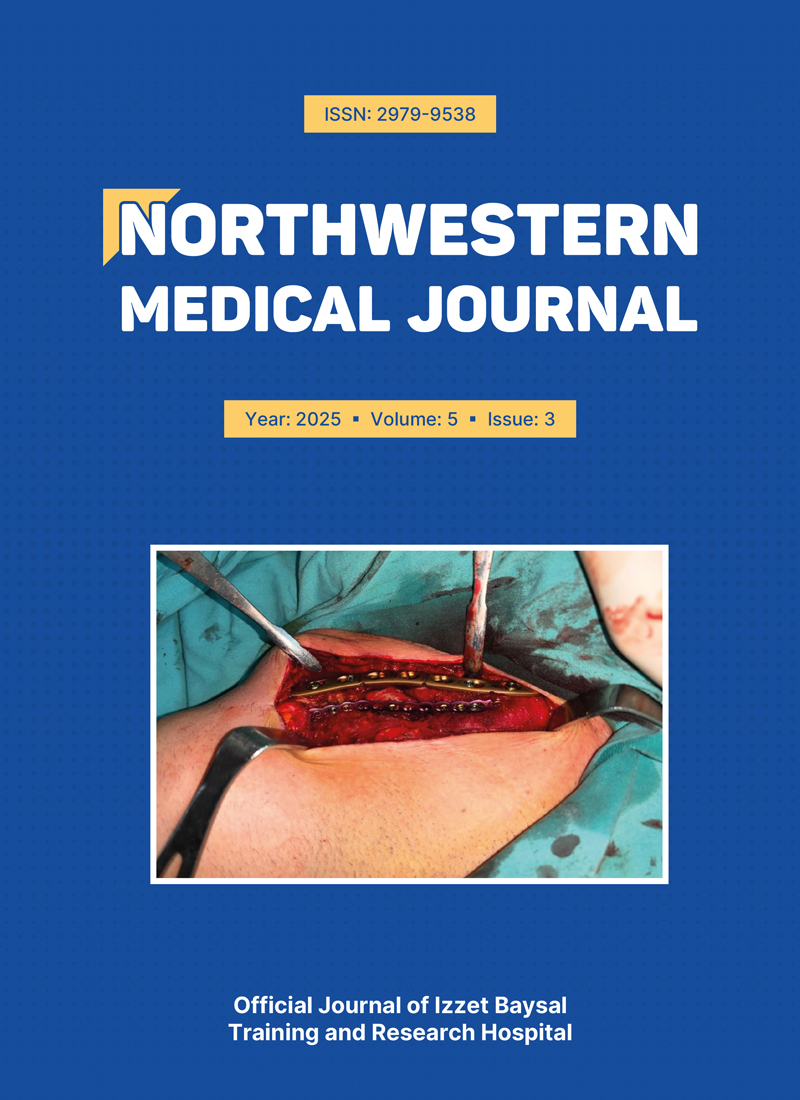Abstract
Objective: Pulmonary thromboembolism (PTE) presents with a wide range of symptoms, outcomes, and radiographic features. We evaluated the clinical, laboratory, and radiological features of PTE.
Materials and Methods: A retrospective study was conducted on patients diagnosed with pulmonary thromboembolism (PTE) between 2019 and 2021 at the Department of Chest Diseases, Abant Izzet Baysal University Hospital. Patients with suspected acute PTE and those diagnosed with pulmonary embolism based on CT angiography were included. Patients with chronic PTE, as diagnosed by ventilation/perfusion scintigraphy, were excluded.
Results: Of the 100 patients included, 42% were female and 58% were male. The mean age of the patients was 70.50 ± 13.54 years. The most common symptom was dyspnea, followed by cough and chest pain. Troponin I levels were elevated in 62 individuals. D-dimer concentrations of all patients were above the upper limit of 0.55 mg/L. Massive PTE was seen in 15% of patients, submassive PTE in 40%, and non-massive PTE in 45%. In addition, systolic pulmonary artery pressure (sPAP) was high in 67% of the cases. Patients with elevated sPAP had a higher mean age, had received more thrombolytic therapy, and had a higher rate of major and submassive pulmonary embolisms. Troponin I values were seen to be elevated in massive PTE, as expected (p=0.024). D-dimer values were significantly higher in patients with pulmonary embolism in the main branch (p=0.018).
Conclusion: In light of the data we obtained from our study, we believe that a detailed cardiovascular system evaluation, including Troponin I and systolic pulmonary artery pressure measurements, is very important in the diagnosis process and in predicting the prognosis after diagnosis in patients presenting with suspected pulmonary thromboembolism.
Keywords: D-dimer, pulmonary embolism, systolic pulmonary artery pressure
Copyright and license
Copyright © 2025 The Author(s). This is an open-access article published by Bolu İzzet Baysal Training and Research Hospital under the terms of the Creative Commons Attribution License (CC BY) which permits unrestricted use, distribution, and reproduction in any medium or format, provided the original work is properly cited.
How to cite
References
- Grippi MA, Elias JA, Fishman JA, Kotloff RM, Pack AI, Senior RM. Fishman’s Pulmonary Diseases and Disorders. McGrowHill; 2015.
- Torbicki A, Perrier A, Konstantinides S, et al. Acute Pulmonary Embolism Diagnosis and Treatment Guide. Eur Heart J. 2008; 29(18): 2276-315. https://doi.org/10.1093/eurheartj/ehn310
- Goldhaber SZ, Bounameaux H. Pulmonary embolism and deep vein thrombosis. Lancet. 2012; 379(9828): 1835-46. https://doi.org/10.1016/S0140-6736(11)61904-1
- Meyer G, Vicaut E, Danays T, et al. Fibrinolysis for patients with intermediate-risk pulmonary embolism. N Engl J Med. 2014; 370(15): 1402-11. https://doi.org/10.1056/NEJMoa1302097
- Taş Gülen Ş. Pulmonary Thromboembolism: Definition and Epidemiology SUMMARY. Turkiye Klin J Pulm Med-Special Top. 2016; 9(1): 6.
- Meinel FG, Nance JW, Schoepf UJ, et al. Predictive Value of Computed Tomography in Acute Pulmonary Embolism: Systematic Review and Meta-analysis. Am J Med. 2015; 128(7): 747-59.e2. https://doi.org/10.1016/j.amjmed.2015.01.023
- Turkish Thoracic Association. Turkish Thoracic Society Pulmonary Thromboembolism Diagnosis and Treatment Consensus Report 2021. 2021.
- Konstantinides SV, Torbicki A, Agnelli G, et al. 2014 ESC guidelines on the diagnosis and management of acute pulmonary embolism. Eur Heart J. 2014; 35(43): 3033-80. https://doi.org/10.1093/eurheartj/ehu283
- Barco S, Ende-Verhaar YM, Becattini C, et al. Differential impact of syncope on the prognosis of patients with acute pulmonary embolism: a systematic review and meta-analysis. Eur Heart J. 2018; 39: 4186-95. https://doi.org/10.1093/eurheartj/ehy631
- Özyol G. Eleveted cardiac troponin I in patient with pulmonary embolism [dissertation]. Sivas: Cumhuriyet University; 2009.
- Kaçmaz B. Retrospective evaluation of hematological parameters of the pulmonary thromboembolism cases related with risk factors and hypercoagulability [dissertation]. Ankara: University of Health Sciences; 2018.
- Aytemur Solak Z, Gündüz Telli C, Kabaroğlu C, Doğan B, Bayındır Ü, Erdener D. Pulmoner Emboli Tanisinda D- Dimer Testinin Yeri. Solunum Hastalıkları. 2003; 14(1): 11-6.
- Hacıevliyagil SS, Mutlu LC, Kızkın Ö, Günen H, Gülbaş G. Altmışüç Pulmoner Emboli Olgusunun Retrospektif Değerlendirilmesi. Solunum Hastalıkları. 2004; 15: 15-21.
- Erbaycu AE, Tuksavul F, Uçar H, Güçlü SZ. Retrospective Evaluation of Forty-nine Pulmonary Embolism Cases. Izmir Chest Diseases Journal. 2004; 18(3): 113-8.
- de Monyé W, van Strijen MJ, Huisman MV, Kieft GJ, Pattynama PM. Suspected pulmonary embolism: prevalence and anatomic distribution in 487 consecutive patients. Radiology. 2000; 215(1): 184-8. https://doi.org/10.1148/radiology.215.1.r00ap22184
- Oser RF, Zuckerman DA, Gutierrez FR, Brink JA. Anatomic distribution of pulmonary emboli at pulmonary angiography: implications for cross-sectional imaging. Radiology. 1996; 199(1): 31-5. https://doi.org/10.1148/radiology.199.1.8633168
- Köyden B. Clinical determinants of pulmonary embolism [dissertation]. Eskişehir: Eskişehir Osmangazi University; 2012.
- Bayram T. The relationship between the heart heart functions and heart rate variability evalued by echocardiographic evaluation in patients with acute pulmonary embolism [dissertation]. İstanbul: Marmara University; 2018.
- Rodoplu E. Correlation of plasma D-dimer level and severity of community acquired pneumonia and as differantial diagnosis of D-dimer in pulmonary embolism and pneumonia [dissertation]. Bursa: Uludağ University; 2006.











